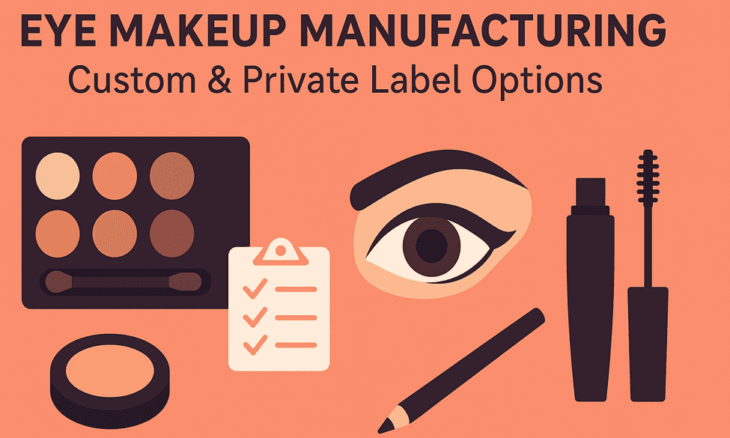
Last Updated on September 30, 2025 by Surender Kumar
Your customers see your brand in that sleek eyeshadow quad, the bold eyeliner, the lash-defining mascara. But behind that polish is a web of technical choices and manufacturing decisions. For Canadian beauty entrepreneurs, understanding the path from concept to shelf is essential—especially when you want to offer something unique without building your own factory.
In this article, I break down the landscape of eye makeup manufacturing, explain the roles of custom vs private label, share how to pick partners, and point out real challenges. I also slip in “Private label eyeshadow palette manufacturer” early for SEO, and later “private label cosmetics manufacturer” where it fits naturally.
Table of Contents
Why Eye Makeup Manufacturing Matters for Your Brand
The global eye makeup market is sizable and still growing. In 2023, it was estimated at USD 18.2 billion, and forecasts suggest it could reach ~USD 26.8 billion by 2030 (CAGR ~5.7 %) Grand View Research.
Another source places 2025’s valuation at USD 20.27 billion and projects it to hit ~USD 25.43 billion by 2030 Mordor Intelligence.
Meanwhile, the private label cosmetics manufacturing market is also expanding rapidly; in 2024 it was valued at ~USD 45,400 million and is expected to grow at ~8 % CAGR through 2032 Credence Research Inc.. This trend shows a rising appetite among brands to outsource rather than build from scratch.
In Canada, the broader cosmetic and beauty products manufacturing sector has been growing at around 4.4 % CAGR (2020–2025) IBISWorld. The Canadian color cosmetics market earned about USD 2.7 billion in 2022 and analysts expect it could reach ~USD 5.5 billion by 2030 Xiran Makeup Manufacturer. All of these pieces show there’s room for new players who can deliver quality, differentiation, and speed.
Custom vs Private Label: What’s the Difference?
When you decide to bring an eye makeup line to market, you generally have two paths:
| Aspect | Private Label | Custom / Contract Manufacturing |
| Starting point | Use a manufacturer’s existing formula with branding changes | Develop your own unique formulas from scratch |
| Lead time | Faster (you pick from what’s ready) | Slower (R&D, testing, iteration) |
| Flexibility | Some tweaks (shade swaps, packaging) | Full flexibility (ingredients, textures, sizes) |
| Investment | Lower upfront cost | Higher technical and regulatory cost |
| Ownership | You own the branding, manufacturer owns formula | You often own the formula (or co-ownership) |
So if you pick a Private label eyeshadow palette manufacturer, you can skip much of the formulation phase and jump straight to packaging and design. For some startups or specialty lines, private label offers a quicker, less risky route. But if your vision is strong and you want exclusivity, a custom route may better suit you.
Key Steps in Eye Makeup Manufacturing
Whether you go private label or custom, these stages are almost always part of the process:
Concept & Specification
Define what your eye products should feel, cover, last, and look like. What textures? Matte, shimmer, glitter, cream, powder? What target price? What ingredients are off-limits (e.g., cruelty-free, clean beauty, allergen avoidance)?
Formulation & Lab Work
In custom mode, you’ll work with chemists to prototype formulas, test stability, pigmentation, wear, and safety (eye area is sensitive!). In private label, you select from existing formula libraries and ask for limited tweaks.
Regulatory & Safety Testing
In Canada (and most markets), you must comply with Health Canada (or equivalent), ingredient listing rules, possible ophthalmic tests, microbial limits, preservative efficacy, etc.
Packaging & Design
Containers, pans, applicators, labels—packaging influences functionality (e.g. pans staying intact under stress), cost, and shelf appeal. Packaging must match the formula (some formulas can’t take certain plastics or coatings).
Pilot Run & QC
A small trial batch helps you catch inconsistency, shade drift, defects. Quality control must verify color consistency, batch uniformity, moisture content, microbial safety, etc.
Full Production & Scale
Once pilot is approved, you go into full runs. You’ll often negotiate minimum order quantities (MOQs) and manage supply chain logistics.
Distribution & Launch
Product ships to your warehouse or directly to retailers or e-commerce. You must manage inventory, losses, and logistics.
What to Look for in an Eye Makeup Manufacturer (Canada or Overseas)
When choosing a partner (whether custom or private label), consider:
Experience & specialization in eye makeup
Eye area demands high safety and consistency—partnering with a manufacturer who already knows eyelashes, eyeshadow granulation, smudge, migration, etc can save headaches.
Regulatory compliance & certifications
GMP, ISO, banned-ingredient screening, audit history, reliable documentation. A credible private label cosmetics manufacturer will supply full regulatory support.
MOQ & flexibility
Some factories force you into large MOQs (e.g. 10,000 units). For small brands, more flexible batch sizes are helpful. Also check if they allow formula tweaking or palette rearrangement.
Color matching & shade development
You’ll want strong lab tools—spectrophotometers, colorimeters, in-house shade labs. Good manufacturers can match your brand’s swatch with precision.
Packaging capabilities or partners
If they also have packaging services or vetted suppliers, it streamlines your workflow.
Communication & project management
Time zone overlap, responsiveness, English fluency, clear workflow, and sample timetables matter.
Supply chain & raw material sourcing
Are they sourcing stable pigments, high-quality binders, sustainable materials? Are they exposed to disruption?
Quality assurance & consistency
Lot-to-lot uniformity, batch tracking, corrective actions. A strict QA regime is nonnegotiable.
Proximity & shipping logistics
Canadian brands may prefer Canadian or U.S. partners to reduce shipping cost, customs hassle, and lead time.
Challenges & Common Pitfalls (and How to Avoid Them)
- Small batches = high cost
The fewer the units, the more you pay per item. It’s tempting to start tiny, but try to negotiate scalable breakpoints. - Shade drift or formula break
Under heat, humidity, or time, formulas may degrade. Always ask for stability testing (e.g. 3 months at high temp). - Ingredient regulation changes
Ingredient rules change (e.g., banned pigments). Stay updated with Health Canada, EU, or other major markets. - Packaging incompatibility
Some shimmer or metallic formulas attack metal packaging. Check chemistry compatibility early. - Poor QA from manufacturer
If QC tolerances are loose, your final product might suffer. Visit (or audit virtually) manufacturer factories. - Supply chain disruption
Fragile supply chains (for rare pigments or exotic oils) can delay production. Ask about alternate sourcing. - Market differentiation
If your formula or shade line is too generic, it’s hard to stand out. Even private label lines should have points of difference (unique shades, textures, marketing angle).
Example: How a Canadian Niche Eye Brand Could Use These Options
Suppose you run a small indie makeup brand in Calgary. You want a 12-pan palette (matte + shimmer). You discover a mid-sized U.S. private label company that already offers 12-pan eyeshadow layouts with flexible color slots. You:
- Select the layout and case,
- Provide your branding,
- Choose from their library of safe formulas,
- Order 2,000 units in your first run (within their MOQ),
- They handle fill, QC, and paperwork—
- You get branded stock in ~8–10 weeks.
Later, when your sales justify it, you negotiate with them (or a custom partner) to tweak formulas—maybe adding a duochrome finish or using an organic binder.
This hybrid route (starting mostly private label, shifting toward custom) is common in beauty startup strategy.
Tips to Make Your Eye Makeup Line Stronger in Canada
- Local “Made in Canada” claims
If your formulation/assembly is done in Canada, you may qualify for “Product of Canada” labeling (if cost thresholds and last transformation rules are met). Consumers often respond to local branding. - Go clean / cruelty-free / vegan
Canadian and North American consumers expect ethical credentials. A specialized partner will help you with statement verification, certifications, and market claims. - Lean inventory & just-in-time restock
Eye makeup is trend sensitive (color shifts, seasonal palettes). Don’t overcommit to large volume of older shades. - Strong packaging visuals
In eye makeup, packaging is part of the allure (mirror, brush slot, embossing). Work with your manufacturer or packaging vendor early on design. - Shade diversity & undertone awareness
Canadian consumers are diverse in skin tones. If your shade line is too narrow, you’ll limit your reach. - Use digital tools & QA transparency
Some manufacturers (like smart factories) now use real-time defect detection and transparency dashboards (e.g. a Chinese smart factory by Florasis is an example) - Leverage influencer / social proof early
Launch with strong swatch visuals, macro shots, tutorials—especially for eye lines. - Plan regulatory for export
If you plan to ship to the U.S., EU, or Asia, ensure your formulas and labels comply. Even private label partners should support multi-region compliance.
Summary & Recommendations
Eye makeup manufacturing offers two core routes: private label (use ready formulas, lower barrier) and custom / contract (higher control, longer lead time). Your brand’s needs, budget, and scale will guide which path to take.
Canadian beauty entrepreneurs have advantages: proximity to North American partners, consumer preference for local credentials, and a growing domestic cosmetics manufacturing sector with ~4.4 % CAGR.
To pick a manufacturer, weigh experience, regulatory support, flexibility, batch size, and packaging capabilities. Be alert to pitfalls: formula instability, sourcing risks, QA lapses. Use smart planning so you can start lean, test the market, then scale or customize deeper.
If you like, I can also help you build a checklist (or RFP template) for reaching out to private label and custom eye makeup manufacturers. Would you like me to send you that?

I am a passionate blogger having 10 years of experience in blogging and digital marketing. I started List Absolute in 2018 to give my passion a live platform. I have also a good hand in writing unique and quality content. Here I contribute in my free time. Thanks for reading. Let me know if I can help you get your work done in a timely manner.
